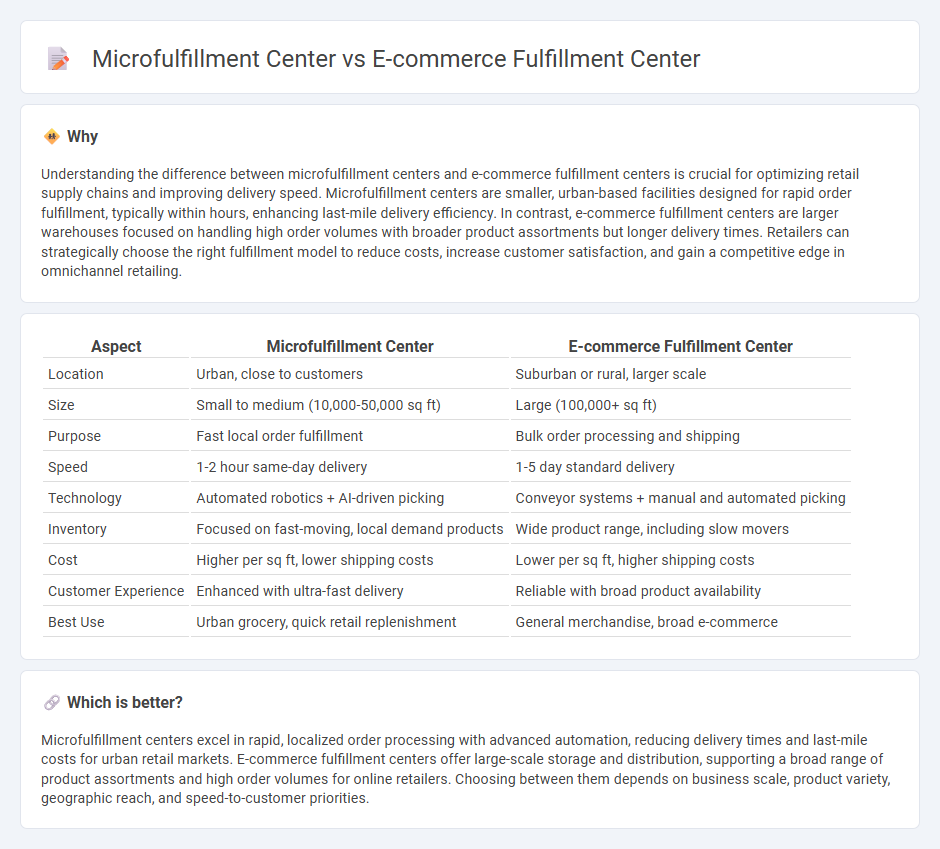
Microfulfillment centers leverage compact, automated warehouses located near urban areas to accelerate order processing and reduce last-mile delivery costs, enhancing the efficiency of grocery and perishable item distribution. E-commerce fulfillment centers typically feature larger-scale operations focused on high-volume storage and shipping, managing diverse product categories with optimized inventory systems to meet broad online retail demands. Explore the differences in operational strategies and technological innovations driving these fulfillment models.
Why it is important
Understanding the difference between microfulfillment centers and e-commerce fulfillment centers is crucial for optimizing retail supply chains and improving delivery speed. Microfulfillment centers are smaller, urban-based facilities designed for rapid order fulfillment, typically within hours, enhancing last-mile delivery efficiency. In contrast, e-commerce fulfillment centers are larger warehouses focused on handling high order volumes with broader product assortments but longer delivery times. Retailers can strategically choose the right fulfillment model to reduce costs, increase customer satisfaction, and gain a competitive edge in omnichannel retailing.
Comparison Table
| Aspect | Microfulfillment Center | E-commerce Fulfillment Center |
|---|---|---|
| Location | Urban, close to customers | Suburban or rural, larger scale |
| Size | Small to medium (10,000-50,000 sq ft) | Large (100,000+ sq ft) |
| Purpose | Fast local order fulfillment | Bulk order processing and shipping |
| Speed | 1-2 hour same-day delivery | 1-5 day standard delivery |
| Technology | Automated robotics + AI-driven picking | Conveyor systems + manual and automated picking |
| Inventory | Focused on fast-moving, local demand products | Wide product range, including slow movers |
| Cost | Higher per sq ft, lower shipping costs | Lower per sq ft, higher shipping costs |
| Customer Experience | Enhanced with ultra-fast delivery | Reliable with broad product availability |
| Best Use | Urban grocery, quick retail replenishment | General merchandise, broad e-commerce |
Which is better?
Microfulfillment centers excel in rapid, localized order processing with advanced automation, reducing delivery times and last-mile costs for urban retail markets. E-commerce fulfillment centers offer large-scale storage and distribution, supporting a broad range of product assortments and high order volumes for online retailers. Choosing between them depends on business scale, product variety, geographic reach, and speed-to-customer priorities.
Connection
Microfulfillment centers and e-commerce fulfillment centers are interconnected by their shared goal of accelerating order processing and delivery for online retail. Microfulfillment centers utilize advanced automation and robotics within urban or dense retail locations to quickly pick and pack orders, complementing larger e-commerce fulfillment centers that handle bulk inventory storage and large-scale distribution. This synergy enhances supply chain efficiency, reduces last-mile delivery costs, and improves customer satisfaction in the competitive retail market.
Key Terms
Order Volume
E-commerce fulfillment centers handle high order volumes with large warehouses designed for bulk storage and long-distance shipping, supporting extensive product assortments. Microfulfillment centers operate with smaller footprints near urban areas, optimizing rapid order processing and delivery for lower to moderate volumes. Explore how choosing the right fulfillment solution can boost efficiency and customer satisfaction in your supply chain.
Location Proximity
E-commerce fulfillment centers are typically large warehouses located on city outskirts or industrial zones, designed for high-volume order processing but often positioned far from urban customers. Microfulfillment centers prioritize location proximity by operating smaller facilities within or near urban areas, enabling faster delivery times and reducing last-mile logistics costs. Explore how these location strategies impact delivery efficiency and customer satisfaction in modern retail.
Automation
E-commerce fulfillment centers typically handle large-scale order processing with extensive automation systems designed for high volume efficiency, including robotic pickers and conveyor belts. Microfulfillment centers emphasize rapid, localized order processing, utilizing compact, automated solutions such as automated storage and retrieval systems (AS/RS) and robotic shuttles to speed up last-mile delivery. Explore how these automation technologies transform supply chain speed and accuracy to optimize your fulfillment strategy.
Source and External Links
Ecommerce Fulfillment Guide: How To Win at Order Fulfillment (2025) - An ecommerce fulfillment center is a warehouse where online retailers store inventory, pick and pack orders, ship products, and manage returns to ensure efficient delivery and customer satisfaction.
Ecommerce Fulfillment 101 - ShipBob - Fulfillment centers handle key logistics for ecommerce brands, including receiving goods, storing inventory, picking and packing orders, shipping, and processing returns, often through third-party fulfillment partners that help optimize costs and operations.
E-commerce Fulfillment Solutions | Ryder 3PL Fulfillment - Modern ecommerce fulfillment centers like Ryder's combine advanced technology, strategically located warehouses, and scalable services including inventory and returns management to support seamless and personalized order fulfillment.
 dowidth.com
dowidth.com